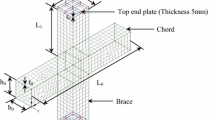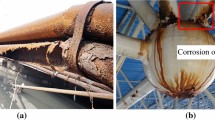Abstract
The copper-titanium bimetallic composite bent tube, which could integrate the advantages of physical, chemical, and mechanical properties of two materials, shows an urgent application demand prospect in mechanical manufacturing, marine operations, and other industrial fields. This paper develops a research on the modeling of rotary-draw bending of copper-titanium composite tube by using two kinds of grid elements S4R and C3D8R, respectively. The contact problem of base tube and covered tube is set as coulomb friction contact mode, whose optimal friction coefficient is obtained by pressure-shearing experiment and its simulation. The springback model is established by considering the contact action of the two tubes. Finally, the S4R shell FE model is compared with the C3D8R solid FE model from the two aspects of section deformation and springback. It is found that the shell element model is accurate in predicting the springback and section deformation, while the solid element model has a large deviation from the experimental results in predicting the section deformation. In order to gain a deeper understanding of the plastic deformation behavior of the bimetallic composite tube, the tangential stress, equivalent stress, equivalent strain, and damage values have been studied. Results show that (1) there is no significant uneven deformation between the base tube and the covered tube, which will not produce obvious wrinkling and section distortion even without the filling of the mandrel dies. (2) Sliding and stratification are existing between the base tube and the covered tube in the bending process. (3) The force of the dies on the base tube is transmitted through the side surface contact between the base tube and the covered tube. (4) The maximum damage value of the covered tube is larger than that of the base tube. This research will promote the development of precise plastic processing technology and play a role in the research of secondary plastic forming of metal composite tubes.














Similar content being viewed by others
References
Wang HF, Han JT, Hao QL (2015) Fabrication of laminated-metal composite tubes by multi-billet rotary swaging technique. Int J Adv Manuf Technol 76:713–719. https://doi.org/10.1007/s00170-014-6302-9
Chen H, Ma HZ, Chen XM, Jiang SF, Wang HJ (2015) Failure analysis of butt weld of bimetal composite pipes. J Fail Anal Prev 15:563–570. https://doi.org/10.1007/s11668-015-9978-8
Tavassolimanesh A, Nia AA (2017) A new approach for manufacturing copper-clad aluminum bimetallic tubes by friction stir welding (FSW). J Manuf Process 30:374–384. https://doi.org/10.1016/j.jmapro.2017.10.010
Lapovok R, Ng HP, Tomus D, Estrin Y (2012) Bimetallic copper-aluminium tube by severe plastic deformation. Scr Mater 66:1081–1084. https://doi.org/10.1016/j.scriptamat.2012.03.004
Li WY, Wen Q, Yang XW, Wang YS, Gao DL, Wang WB (2017) Interface microstructure evolution and mechanical properties of Al/cu bimetallic tubes fabricated by a novel friction-based welding technology. Mater Des 134:383–393. https://doi.org/10.1016/j.matdes.2017.08.065
Jiang WM, Fana ZT, Li C (2015) Improved steel/aluminum bonding in bimetallic castings by a compound casting process. J Mater Process Technol 226:25–31. https://doi.org/10.1016/j.jmatprotec.2015.06.032
Liu XH, Zou WJ, Fu HD, Liu XF, Xie JX (2017) Cu/Ti bimetal composite pipe fabricated by heating rotary swaging forming and its interface, microstructure and properties. Chin J Rare Metals 04:364–370 (in Chinese). https://doi.org/10.13373/j.cnki.cjrm.XY16110005
Liu XH, Lin YL, Fu HD, Liu XF, Xie JX (2017) Preparation of the capillary copper/titanium composite pipe by floating-plug drawing processing and its microstructure and properties. Chin J Eng 39:417–425 (in Chinese). https://doi.org/10.13374/j.issn2095-9389.2017.03.014
Zhai YB, Liu CM, Wang K, Zou MH, Xie Y (2010) Characteristics of two Al based functionally gradient composites reinforced by primary Si particles and Si/in situ Mg2Si particles in centrifugal casting. Trans Nonferrous Metals Soc China 20:361–370. https://doi.org/10.1016/S1003-6326(09)60147-3
Hejazi MM, Divandari M, Taghaddos E (2009) Effect of copper insert on the microstructure of gray iron produced via lost foam casting. Mater Des 30:1085–1092. https://doi.org/10.1016/j.matdes.2008.06.032
Li CZ, Tang HY, Li JS, Yang HB (2013) Numerical simulation of misrun defect of bimetallic composite pipe by investment casting. Appl Mech Mater 251:442–445. https://doi.org/10.4028/www.scientific.net/AMM.251.442
Guo XZ, Wei WB, Xu Y, Abd El-Aty A, Liu H, Wang H, Luo XY, Tao J (2019) Wall thickness distribution of cu–Al bimetallic tube based on free bending process. Int J Mech Sci 150:12–19. https://doi.org/10.1016/j.ijmecsci.2018.10.013
Li H, Yang H, Song FF, Zhan M, Li GJ (2012) Springback characterization and behaviors of high-strength Ti-3Al-2.5V tube in cold rotary draw bending. J Mater Process Technol 212:1973–1987. https://doi.org/10.1016/j.jmatprotec.2012.04.022
Wen T (2014) On a new concept of rotary draw bend-die adaptable for bending tubes with multiple outer diameters under non-mandrel condition. J Mater Process Technol 02:311–317. https://doi.org/10.1016/j.jmatprotec.2013.09.019
Liao J, Xue X, Lee MG, Barlat F, Gracio J (2014) On twist springback prediction of asymmetric tube in rotary draw bending with different constitutive models. Int J Mech Sci 89:311–322. https://doi.org/10.1016/j.ijmecsci.2014.09.016
Xue X, Liao J, Vincze G, Gracio JJ (2015) Modelling of mandrel rotary draw bending for accurate twist springback prediction of an asymmetric thin-walled tube. J Mater Process Technol 216:405–417. https://doi.org/10.1016/j.jmatprotec.2014.10.007
Liu N, Yang H, Li H, Tao ZJ, Hu X (2015) An imperfection-based perturbation method for plastic wrinkling prediction in tube bending under multi-die constraints. Int J Mech Sci 98:178–194. https://doi.org/10.1016/j.ijmecsci.2015.03.023
Zhang HL, Liu YL, Yang H (2016) Deformation behaviors of double-ridged rectangular H96 tube in rotary draw bending under different mandrel types. Int J Adv Manuf Technol 82:1569–1580. https://doi.org/10.1007/s00170-015-7468-5
Liu YL, Zhu YX, Dong WQ, Yang H (2013) Springback prediction model considering the variable Young’s Modulus for the bending rectangular 3A21 tube. J Mater Eng Perform 22:9–16. https://doi.org/10.1007/s11665-012-0227-y
Zhu YX, Chen W, Li HP, Liu YL, Chen L (2018) Springback study of RDB of rectangular H96 tube. Int J Mech Sci 138-139:282–294. https://doi.org/10.1016/j.ijmecsci.2018.02.022
Gearing BP, Moon HS, Anand L (2001) A plasticity model for interface friction application to sheet metal forming. Int J Plast 17:237–271. https://doi.org/10.1016/S0749-6419(00)00034-6
Xu H (1991) Machinery’s handbook, 1th edn. China Machine Press, Beijing (in Chinese)
Hilberink A, Gresnigt AM, Sluys LJ (2011) Mechanical behaviour of lined pipe during bending, numerical and experimental results compared. ASME 2011 30th international conference on ocean, offshore and Arctic engineering. Am Soc Mech Eng 04:401–412. https://doi.org/10.1115/OMAE2011-49434
Guo XZ, Tao J, Tang QS, Li HG, Bian JM, Li M (2012) Cold push-bending simulation and experiment on TA1-Al bimetallic clad tube. Chin J Nonferrous Metals 22:1053–1062 (in Chinese). https://doi.org/10.19476/j.ysxb.1004.0609.2012.04.010
Kobayashi S, Oh S, Altan T (1989) Metal forming and the finite-element method. Oxford University Press, New York
Kong CM, Liao HY (2016) Analysis on the tearing principle between layers of the cold rolled bi-metal composite pipe. Forging and Stamping Technology 41:142–148 (in Chinese). https://doi.org/10.13330/j.issn.1000-3940.2016.10.027
Zhu YX, Liu YL, Li HP, Yang H (2013) Comparison between the effects of PVC mandrel and mandrel-cores die on the forming quality of bending rectangular H96 tube. Int J Mech Sci 76:132–143. https://doi.org/10.1016/j.ijmecsci.2013.09.011
Funding
The research is supported by National Natural Science Foundation of China (No. 51601070), Natural Science Foundation of Jiangsu Province (No. BK20181447), Postdoctoral Science Foundation of Jiangsu Province (No. 1501099B), and Senior Talent Foundation of Jiangsu University (No. 14JDG135).
Author information
Authors and Affiliations
Corresponding author
Additional information
Publisher’s note
Springer Nature remains neutral with regard to jurisdictional claims in published maps and institutional affiliations.
Rights and permissions
About this article
Cite this article
Zhu, Y.X., Chen, W., Tu, W.B. et al. Three-dimensional finite element modeling of rotary-draw bending of copper-titanium composite tube. Int J Adv Manuf Technol 106, 2377–2389 (2020). https://doi.org/10.1007/s00170-019-04781-0
Received:
Accepted:
Published:
Issue Date:
DOI: https://doi.org/10.1007/s00170-019-04781-0




